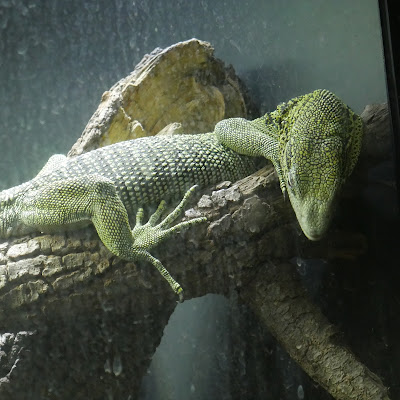I love a good herpetarium, and they are not that common at most zoos. Often Reptiles and Amphibians are scattered in and among other collections of animals in say a "Tropics House." Sometimes this works, I would say that the Denver Zoo's arrangement is particularly successful, while the Reptiles included in the expanded Jaguar/Tropical Aviary habitat at the Woodland Park Zoo in Seattle tends to lose the snakes in the rest of the spectacle. Some Zoos try to create a dedicated building, which often feels like an afterthought, a box to check off in broadening the range of species. The smaller the zoo, the less successful the attempt. So where are some great Herpetariums? The Smithsonian National zoo has a pair in the Reptile House and the Amazonia Tropical Forest building. The Philadelphia Zoo has arguably the first modern Herpetarium and after a major overhaul a few years back one of the finest. And then there is the Virginia Zoo in Norfolk.
About 5 years ago now, if memory serves me, it opened an expanded and ambitious new Herpetarium called "Reptiles of the World and their Friends". Nestled a wee bit off the beaten path between the Beastro Cafe and the Children's Petting Zoo, it's honestly possible to visit the zoo and completely miss it, or think it no big deal. However, you would have missed one of the best things about the Virginia Zoo and one of the best Herpetariums in the nation.
The design in organic and "snakes" around from entrance to exit presenting the visitor with dozens of habitats, medium, large and extra large in size. There are two working labs where species survival is front and center with arches of glass walls to peek inside and discover what goes on in a poison dart frog fertility lab, or what do infant boa constrictors eat? Not for the faint of heart. Around one turn is a series of large aquariums featuring, exotic newts, water snakes, and even seahorses. The largest feature is a huge pool full of enormous cichlids and koi and a pair of very content Siamese Crocodiles.
The last thing you see is a series of 4 habitats, large vertical spaces arranged in a reverse bay window. Each is home to a different species of Tree Monitor Lizard--all with Color names: Blue, Black, Green and Yellow. It creates an amazing, real-time opportunity to compare the stunning and unique coloration of each to the other.
On the way out is large aviary which was originally designed to be shared by small primates, titi monkeys, a three-toed sloth, and some copacetic bird species. The very first time I visited, the space was still under construction. The second time, it was homes to tropical plants, but animals were yet added. Today, I found the plants and a couple of species of birds, Nicobar Dove and a species of Myna. No primates. I get the sense that in leaving some areas incomplete, the zoo may have bitten off more than it can chew when it set about designing the entire complex. But if one lacking aviary is the only issue, I am so grateful that they went ahead with the rest. And the fact that they have intentionally made space for animals from all corners of the world and in many cases with conservation concerns is really what makes this place unique.
Conservation Status: Vulnerable















No comments:
Post a Comment